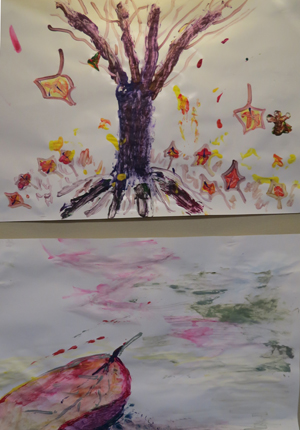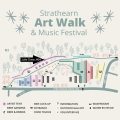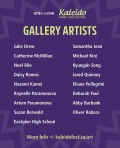 Julie Drew Where Art Meets Faith
Julie Drew Where Art Meets Faith 
Sam Drew
 The first excericise in our Art, Vocabulary for the Soul retreat this last weekend, we responded to the question: "How do you find rest?" Next we traded paintings, and in the second excercise we painted a second painting as a response to the painting we had been given. These two exercises together help us focus on two key ideas of the retreat, listening and trusting the process. We listened to ourselves in the first exercise, and we listened to the painting of another in the second exercise. Painting is always a process, we don't know the end from the beginning. Each painting is a journey with much for us to observe both in the painting and ourselves along the way. The journey continues as another responds to our painting, and as we respond to another's painting. The story begins in one person's heart and continues in another's, and the process of God's work in us weaves through it all.
The first excericise in our Art, Vocabulary for the Soul retreat this last weekend, we responded to the question: "How do you find rest?" Next we traded paintings, and in the second excercise we painted a second painting as a response to the painting we had been given. These two exercises together help us focus on two key ideas of the retreat, listening and trusting the process. We listened to ourselves in the first exercise, and we listened to the painting of another in the second exercise. Painting is always a process, we don't know the end from the beginning. Each painting is a journey with much for us to observe both in the painting and ourselves along the way. The journey continues as another responds to our painting, and as we respond to another's painting. The story begins in one person's heart and continues in another's, and the process of God's work in us weaves through it all.
The paintings and poem below (or to the right) show how intricately the whole process can work. The first painting, by Sam Drew, is a tree in fall with all the leaves in beautiful colors fallen or falling to the ground. (We use finger painting and tempera paints for our Friday evening exercises so there is less emphasis on precision in painting, and more on just letting the images out) For Sam this tree in fall was an image of rest. The second painting, just below the first, was the "response painting" by Ruth. The leaves of Sam's painting stood out to her, and she drew just one leaf, resting gently on the ground.
The process continued in Sam's heart as he listened for God's word for him during the weekend. Both paintings, the beautiful scenery of King's Fold, the scriptures, and the idea of resting mixed together in his spirit, and he tried to let God's Spirit sort it out. The poem below, took shape in that process, and Sam shared it at our time of worship and sharing on Sunday afternoon.
A Leaf in the Wind - Sam Drew
All my life
has been about
being connected
until
It seems
that maybe it is not.
I know the wind,
or I thought I did,
often it blew through the valley,
and we felt
its warm breath of gentleness,
or crisp, cool freshness,
or harsh unpredictable strength.
We enjoyed the wind
or endured the wind
from the shelter of the tree,
connected to the tree.
The tree is the source of
food,
strength,
help,
security,
warmth and care,
protection,
life,
identity,
truth,
meaning,
place,
purpose.
The wind is
unpredictable,
unmanageable,
at times fearsome,
untrustworthy
until, maybe it is not.
The wind
was gentle,
a breeze.
It did not pull so hard,
or twist,
but perhaps,
in just the right way,
in just the right places,
It wasn't even so much
that it pulled me away
as I
let go
all that I had held on to
so tightly
for so long,
all that was so important,
so necessary,
that life,
that connectedness,
all I knew
until it was not.
Until I trusted,
rested
in the wind
and let go.
I don't know
where it comes from,
I don't know
where it goes.
I am a leaf in the wind.
Julie asked me to write something for her website about the Enneagram as we are preparing for another Introduction to the Enneagram course in Edmonton in February. And I have decided to share a little about taking care of myself.
Luke writes in Chapter 10:38-42
38 Now as they went on their way, he entered a certain village, where a woman named Martha welcomed him into her home. 39 She had a sister named Mary, who sat at the Lord’s feet and listened to what he was saying. 40 But Martha was distracted by her many tasks; so she came to him and asked, “Lord, do you not care that my sister has left me to do all the work by myself? Tell her then to help me.” 41 But the Lord answered her, “Martha, Martha, you are worried and distracted by many things; 42 there is need of only one thing. Mary has chosen the better part, which will not be taken away from her.”
“Martha was distracted by her many tasks...Martha, Martha, you are worried and distracted by many things...” These words describe what I experience and feel much of the time. This fall I am involved in fewer activities than I have been in a long time, our children require less from us than they have in 27 years, I’m not doing any preaching, teaching, or leading at church and I still often feel as burdened as ever by the tasks I need to do. And, like Martha, I can easily resent others who don’t come to my aid, like Mary, or who don’t recognize and praise my hard work, like Jesus.
I suspect that this wasn’t just something Martha did when Jesus came over. Filling her life with tasks and getting things done was likely a strategy that had given her significant success in life. It is often said that 20% of the people get 80% of the work done, and she was certainly one of those 20%, and it probably paid off for her. That’s my experience. I’m a busy person, I like to help people, to get things done, to work hard, and to take on new and challenging tasks. And, to a large extent, people admire and appreciate it.
But, as Jesus makes clear, there are also some downsides to so much focus on tasks and doing -- helping so much, serving so much, or whatever particular form it takes in our lives. We can be so focused on getting our tasks done that we miss Jesus, or our spouse, or children, or the friend at work who needs someone to listen, or even ourselves and our own needs.
And we can read the story of Mary and Martha, we can hear sermons preached on it, we can make declarations to change, we can take classes and read books on it, we can even put slowing down on our task list, and try our best to do it. Certainly, these ideas have worked for some, but for many, like myself, they have never led to long term, permanent change. It’s as if there is more that is needed than simply changing what I know or what I do, and that’s where what I am learning from the Enneagram is helping me.
In the Enneagram Personality Styles I tend to favor type 2. Two’s are helpers, they like to meet needs, even rescue people. Two’s pay close attention to the people around them and are quick to spot when something needs to be done. Again, these can all be very good things, but they are not healthy when they are done in order to feel loved and needed. Which, the Enneagram teaches, is a direction two’s can easily go. We discover that being helpful gets us love and attention, and we come to believe that if we are not helpful we won’t be loved.
People have commented to me that they don’t like personality profiles because it tends to put people in boxes. I like the Enneagram because it helps us see the boxes we put ourselves in. They are boxes like Martha’s and my own distraction and anxiety about many tasks. They tend to help us survive or even excel in some parts of life, but, by living in them, we can miss some or much of God, others, and ourselves. And we can’t get out of them until we know they are there and recognize what they are and recognize why they have been important to us. The Enneagram helps us with all these things. It’s a wonderful tool for personal and spiritual transformation.
As an Enneagram two, one of the most important directions for growth for me is to learn to care for myself, as well as caring for others, and learn that it is not something to feel guilty about. As I mentioned, I’m trying to take time away from so many responsibilities, but I’m not just changing what I do, but, with the help of the Enneagram, learning to see myself, God, and the world in a healthier way.
Sam Drew
 Sam is a spiritual director and Christian teacher. He has taught and led numerous one day retreats and week-long courses on topics of spiritual formation, including "Writing Your Spiritual Autobiography", "The Theology of Spiritual Formation," and the "Institute of Spiritual Formation" through the Urban Sanctuary in Edmonton. He also preaches regularly as part of the Teaching Team at Calvary Baptist Church in Edmonton. Sam has a Master of Divinity and Certificate of Spiritual Direction from North Park Seminary in Chicago, as well as a Certificate of Spiritual Formation from the Urban Sanctuary.
Sam is a spiritual director and Christian teacher. He has taught and led numerous one day retreats and week-long courses on topics of spiritual formation, including "Writing Your Spiritual Autobiography", "The Theology of Spiritual Formation," and the "Institute of Spiritual Formation" through the Urban Sanctuary in Edmonton. He also preaches regularly as part of the Teaching Team at Calvary Baptist Church in Edmonton. Sam has a Master of Divinity and Certificate of Spiritual Direction from North Park Seminary in Chicago, as well as a Certificate of Spiritual Formation from the Urban Sanctuary.






